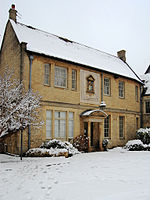St Peter's College, Oxford
1929 establishments in EnglandBuildings and structures of the University of OxfordColleges of the University of OxfordEducational institutions established in 1929St Peter's College, Oxford ... and 1 more
Use British English from April 2018

St Peter's College is one of the constituent colleges of the University of Oxford. Located on New Inn Hall Street, Oxford, United Kingdom, it occupies the site of two of the university's medieval halls dating back to at least the 14th century. The modern college was founded by Francis James Chavasse, former Bishop of Liverpool, opened as St Peter's Hall in 1929, and achieved full collegiate status as St Peter's College in 1961. Founded as a men's college, it has been coeducational since 1979.As of 2022, the college had an estimated financial endowment of £53.9 million.
Excerpt from the Wikipedia article St Peter's College, Oxford (License: CC BY-SA 3.0, Authors, Images).St Peter's College, Oxford
New Road, Oxford City Centre
Geographical coordinates (GPS) Address External links Nearby Places Show on map
Geographical coordinates (GPS)
| Latitude | Longitude |
|---|---|
| N 51.752762 ° | E -1.260721 ° |
Address
St Peter's College
New Road
OX1 1LT Oxford, City Centre
England, United Kingdom
Open on Google Maps









